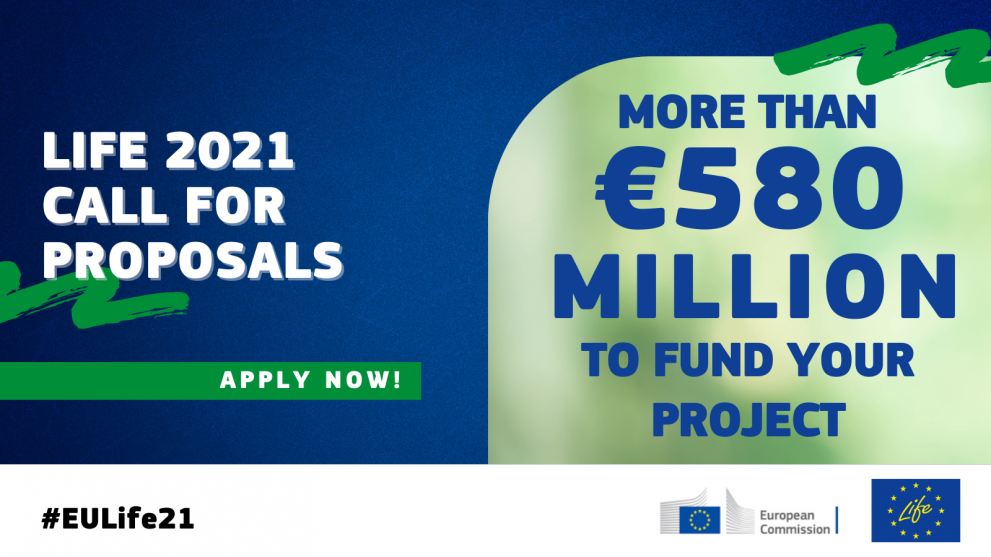
Applicants to the LIFE Call for proposals should aim to address one or more of these priority topics.
The topics fall under LIFE’s four new sub-programmes: nature and biodiversity, circular economy and quality of life, climate change mitigation and adaptation, and clean energy transition.
See a summary of the topics, the kinds of projects we are looking for, and some LIFE project examples below.
Don’t forget that we are holding a LIFE Call for proposals Q&A session on 8 & 9 September.
Sub-programme: nature and biodiversity
There are two priorities under the nature and biodiversity sub-programme:
- Supporting the objectives set out in the EU Birds and Habitats Directives and the Invasive Alien Species Regulation.
- Contributing to the targets of the EU Biodiversity Strategy to 2030 for a Trans-European Nature Network and the EU Restoration Plan.
Also, there are two areas of intervention:
- Space for nature: area-based conservation and restoration measures.
- Safeguarding our species: measures targeting specific species.
Project examples:
- GrassLIFE - developing and improving the conservation status of five EU priority grasslands.
- Egyptian Vulture new LIFE - stabilising the Balkan population of the Egyptian vulture in Bulgaria and Greece.
- LIFE WOLFALPS EU - improving wolf-human coexistence in the Alpine wolf population.
- Life Terras do Priolo - restoring 26 hectares of laurel forest habitat in Portugal and creating a protection ring against the entry of invasive flora.
- LIFE URBANBEES - enhancing the biodiversity of wild bees in Europe’s urban habitats.
- LIFE14 Roseate tern – improving prospects for this species in the UK and Ireland.
Sub-programme: circular economy and quality of life
There are seven priorities under the circular economy and quality of life sub-programme:
- Recovery of resources from waste – innovative solutions for value-added recycled materials, components, or products.
- Circular economy and the environment – supporting value chains set out in the EU Circular Economy Action Plan.
- Air – helping to implement air quality legislation and addressing urban, industrial, and rural environmental problems.
- Water – improving water quality and quantity as well as marine and coastal water management. Innovative technologies and tools for drinking water and urban wastewater treatment systems.
- Soil - protecting the quality of EU’s soil.
- Noise – reducing noise inside densely populated urban areas.
- Chemicals – lessening the impact of hazardous substances on the environment or human health.
- Environmental governance - supporting public administrations’ decision-making and voluntary approaches, assuring environmental compliance and access to justice, promoting behavioural change and awareness-raising.
Project examples:
- Soil4Life - raising awareness of soil’s importance among farmers, professionals and the public in Italy, France and Croatia.
- LIFE DEBAG - reducing marine litter in Greece through awareness-raising and campaigning.
- LIFE COGENERATION PL - developing a technology that can produce electricity and heat from waste and sewage sludge in Poland.
- LIFE-IP MAŁOPOLSKA - working to improve air quality in Poland’s Małopolska province.
- LIFE IBATHWATER - reducing the impact of discharged untreated rainwater on the environment in Berlin and Barcelona.
- LIFE Waste2Protein - using organic residues from supermarkets as a resource to produce sustainable and location-independent insect protein from black soldier flies.
Sub-programme: climate mitigation and adaptation
There are three priorities under the climate change mitigation and adaption sub-programme:
- Climate change mitigation - reducing fluorinated greenhouse gases, enhancing the functioning of the Emissions Trading System, managing land and sea better to reduce emissions, enhancing natural carbon sinks.
- Climate change adaptation - implementing adaptation plans, developing state of the art adaptation tools, climate-proofing, preparing cities and regions for climate change and extreme weather events.
- Climate governance and information - supporting the European Climate Pact, encouraging behavioural change, raising awareness, monitoring greenhouse gas emissions, analysing climate policy.
Project examples:
- LIFE Carbon Dairy – promoting a new approach to milk production to cut greenhouse gas emissions.
- LIFE@Urban Roofs - stimulating private investment in climate adaptation.
- SOLID LIFE - producing low-emission cement and concrete products on an industrial scale.
- Hg-rid-LIFE - reducing poisonous mercury emissions from Sweden’s dental clinics.
- LIFE ADAPT2CLIMA - helping Mediterranean farmers adapt to climate change.
- LIFE FRANCA - making the shift from flood response to flood prevention in the Italian Alps.
Sub-programme: clean energy transition
There are five priorities under the clean energy transition sub-programme:
- Building a national, regional and local policy framework that supports the clean energy transition.
- Accelerating technology roll-out, digitalisation, new services and business models as well as improving skills.
- Attracting private finance for sustainable energy projects.
- Supporting local and regional investment projects.
- Involving and empowering citizens in the clean energy transition.
Project examples from previous H2020 Energy Efficiency programme:
- ComAct - supporting the alleviation of energy poverty.
- Label 2020 and BELT - helping consumers to select the most energy-efficient appliances.
- Making sustainable energy an attractive investment for public and private investors.
- EMPOWERING - Supporting public authorities to become clean energy transition leaders.
- NOVICE - facilitating new smart energy services and business models.
Details
- Publication date
- 25 August 2021

